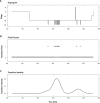NREM sleep stage transitions control ultradian REM sleep rhythm
- PMID: 21966074
- PMCID: PMC3174844
- DOI: 10.5665/SLEEP.1292
NREM sleep stage transitions control ultradian REM sleep rhythm
Abstract
Study objectives: The cyclic sequence of NREM and REM sleep, the so-called ultradian rhythm, is a highly characteristic feature of sleep. However, the mechanisms responsible for the ultradian REM sleep rhythm, particularly in humans, have not to date been fully elucidated. We hypothesize that a stage transition mechanism is involved in the determination of the ultradian REM sleep rhythm.
Participants: Ten healthy young male volunteers (AGE: 22 ± 4 years, range 19-31 years) spent 3 nights in a sleep laboratory. The first was the adaptation night, and the second was the baseline night. On the third night, the subjects received risperidone (1 mg tablet), a central serotonergic and dopaminergic antagonist, 30 min before the polysomnography recording.
Measurements and results: We measured and investigated transition probabilities between waking, REM, and NREM sleep stages (N1, N2, and N3) within the REM-onset intervals, defined as the intervals between the onset of one REM period and the beginning of the next, altered by risperidone. We also calculated the transition intensity (i.e., instantaneous transition rate) and examined the temporal pattern of transitions within the altered REM-onset intervals. We found that when the REM-onset interval was prolonged by risperidone, the probability of transitions from N2 to N3 was significantly increased within the same prolonged interval, with a significant delay and/or recurrences of the peak intensity of transitions from N2 to N3.
Conclusions: These results suggest that the mechanism governing NREM sleep stage transitions (from light to deep sleep) plays an important role in determining ultradian REM sleep rhythms.
Keywords: Ultradian rhythm; serotonin, dopamine; sleep stage dynamics; transition probability.
Figures





References
-
- Aserinsky E, Kleitman N. Regularly occurring periods of eye motility, and concomitant phenomena, during sleep. Science. 1953;118:273–4. - PubMed
-
- Hobson JA, Lydic R, Baghdoyan HA. Evolving concepts of sleep cycle generation: from brain centers to neuronal populations. Behav Brain Sci. 1986;9:371–448.
-
- Jones BE. Paradoxical REM sleep promoting and permitting neuronal networks. Arch Ital Biol. 2004;142:379–96. - PubMed
-
- Luppi PH, Gervasoni D, Boissard R, et al. Brainstem structures responsible for paradoxical sleep onset and maintenance. Arch Ital Biol. 2004;142:397–411. - PubMed
-
- Pace-Schott EF, Hobson JA. Basic mechanisms of sleep: new evidence on the neuroanatomy and neuromodulation of the NREM-REM cycle. In: Kenneth LD, Dennis C, Joseph TC, Charles N, editors. Neuropsychopharmacology: the fifth generation of progress. 5th ed. Philadelphia, PA: Lippincott Williams – Wilkins; 2002. pp. 1859–77.
Publication types
MeSH terms
Substances
LinkOut - more resources
Full Text Sources

